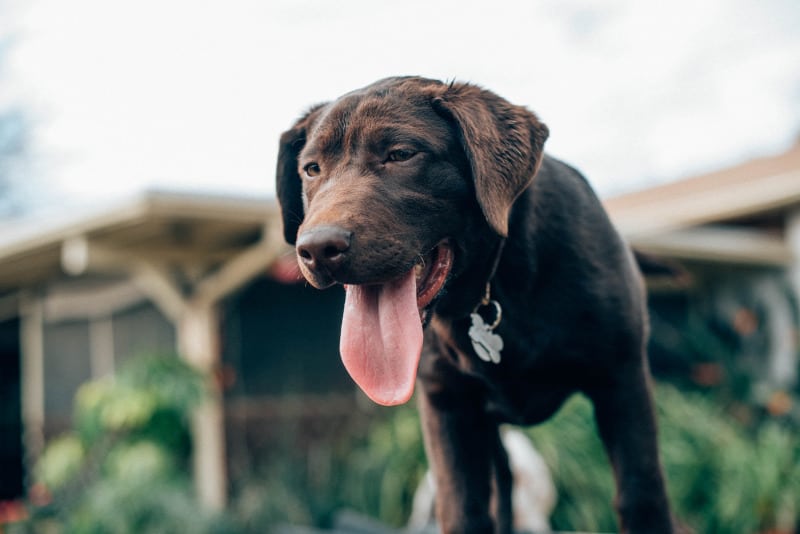Most people who adopt a Labrador Retriever know that they haven’t chosen a small dog.
Labradors are small and adorable as puppies but do grow quickly in their first year or so of life.
These energetic companions are smart, friendly, eager to please, and lovable.
They can be a lot to handle, especially for first-time owners. Or even for those who have previously owned smaller breeds.
After adopting your new Lab, you will have many questions, and soon you will be asking when do Labs stop growing.
Keep reading to learn what factors contribute to the size of your pup and some essential things to remember along the way.
When do Labs Stop Growing?
Labradors mature moderately, reaching an adult height around 1 to 1.5 years, although they may continue to gain weight up to 2 years.
On average, most Labs achieve a life expectancy of 10 to 12 years.

What Does Normal Growth Look Like for a Labrador Retriever?
Normal growth in a Lab may vary from dog to dog but will follow a familiar pattern.
In the first year of life, you can expect rapid growth from your Labrador puppy, given the fact their birth weight averages 17 ounces.
It may feel like your pup had a growth spurt every time you blink.
Studies show that Labs usually reach their peak growth rate at around 12-14 weeks.
They usually reach about half of their ideal adult weight by 18 weeks. If this doesn’t seem drastic enough, most Labs finish skeletal development by nine months of age.
See Also:
When will my Lab calm down
Labrador Growth Stages
Labradors go through different stages of development, which are easy to identify with a trained eye.
These growth stages – newborn, juvenile, adolescence, and adulthood – all come with marked periods of development.
In the newborn and juvenile stage, the first six months of a Lab’s life, your pup will grow fast and complete almost all its skeletal development.
You may notice that your dog looks lanky or slimmer during the latter half of this period.
During adolescence, they will complete skeletal growth. They will then begin to fill out until they reach their full adult weight and height.
As your Labrador Retriever enters adulthood, you will notice a slow in physical growth and weight gain, as well as a calmer demeanor.

Don’t Miss:
Can a Labrador Live in an Apartment or Small House?
When is a Labrador Fully Grown?
Labs officially reach their final size around a year to 18 months considering all the different growth stages.
With adult height and weight achieved, owners must take steps to maintain their dog’s healthy weight and composition.
Labs are a highly active breed that requires training, plenty of exercise, and a balanced diet.
This helps prevent problems with weight gain, which can lead to more dangerous health conditions as your dog continues to age.
You may also notice a change in your dog’s energy level or demeanor.
As puppies pass adolescence and settle into adulthood around two years of age, Labs start to calm. Another sign that your dog has stopped growing.
What Factors Contribute to a Labs Growth?
An average male Lab will stand around 22-23 inches and weigh roughly 65-85 pounds. Female Labradors will grow to 21-22 inches and 55-75 pounds, respectively.
Several factors can affect how large a Lab can be. Many of them are related to elements controlled by the owner rather than the dog.

Food and Nutrition
As with any pet, healthy food and nutrition are essential to ensure that your Lab grows appropriately.
A balanced diet for a Labrador Retriever is a must.
Ensure your pup gets the right amount of fats, nutrients, vitamins, and minerals. All these aids in a healthy growth curve for your dog.
It may be tempting to feed a hungry dog, but overfeeding your Lab can cause problems in their early development.
When you give your young Lab too much food, you may encourage excessive growth that can be taxing on their skeletal structure.
When bones grow too fast, it leads to orthopedic issues in the breed further down the line.
Related:
How much to feed a Lab puppy
Spaying and Neutering
Spaying and neutering can have one of the largest impacts on the optimal growth of your Lab.
Dogs spayed or neutered earlier in their development, around 6-9 months, have growth plates that develop for longer and close later than their “unfixed” counterparts.

The extended period of growth is due to the interference of estrogen and testosterone levels.
These levels are linked to a dog’s sexual maturity and physical development.
This can result in a bigger dog and lead to health issues.
Long bone growth and delayed joint development can cause many orthopedic issues in the breed. The main contributor to health problems is hip dysplasia.
Of course, this isn’t to say you should avoid spaying or neutering your Labs.
Just be aware of the timing and delay operations until crucial skeletal development is complete.
General Health and Genes
The final and most significant factor in determining the size of your fully-grown Labrador is a general health and genetic history of your dog.
If you purchased your puppy from a lineage of larger Labs, you could assume your pup will be slightly larger than an average-sized adult dog.
The same can be said for Labs will family lines that veer towards smaller percentiles.
Overall, what is most important to consider in the growth of your Labrador Retriever is that they have a balanced diet and get plenty of exercise.
A healthy, well-attended puppy will inevitably lead to a well-developed adult dog.
Also See:
Do Labradors Get Cold?
How much do Labs grow after 6 months?
On average, a Labrador puppy would weigh a little above 2 pounds every week.
Thus, by three months of age, a Lab might weigh about 25 pounds and 50 pounds at six months.
How big will my Lab get?
According to AKC Official Standard for the Labrador Retriever, a mature male Lab should stand at 22.5 to 24.5 inches tall and weigh about 65 to 80 pounds.
In contrast, a female should stand at 21.5 to 23.5 inches in full height and weigh around 55 to 70 pounds.
The Buttom Line

Labradors go through different stages of development, which are easy to identify with a trained eye. It’s all a part of the Labrador’s average lifespan.
It is imperative to remember that every Lab will develop differently — breed standard aside.
Genetic factors, appetite, and rate of sexual maturity can all affect the final size of your dog.
Unless you are noticing extreme weight loss, gain, or other health issues in your Lab puppy, your dog is likely to grow as it should.
Though issues related to growth and development are generally uncommon in Labradors, always make sure your pup is getting healthy food, exercise, and stimulation as they mature into adulthood.
You Might Also Like:
Why Do Dogs Roll In Dead Animals? Science Explains







